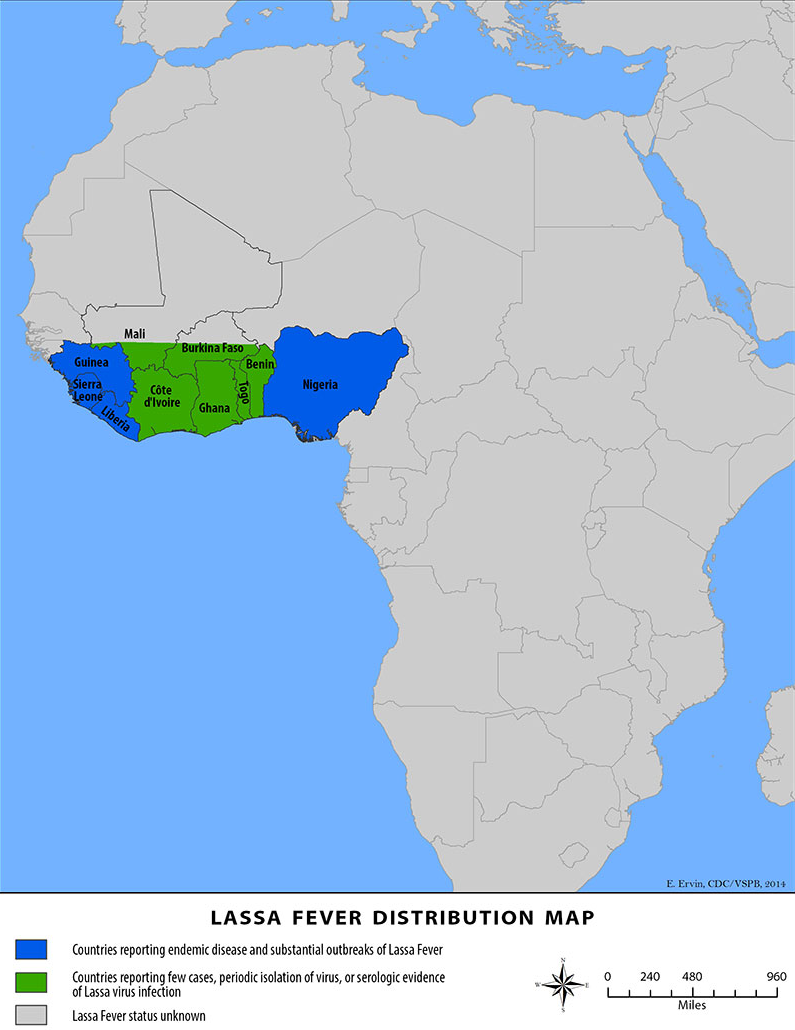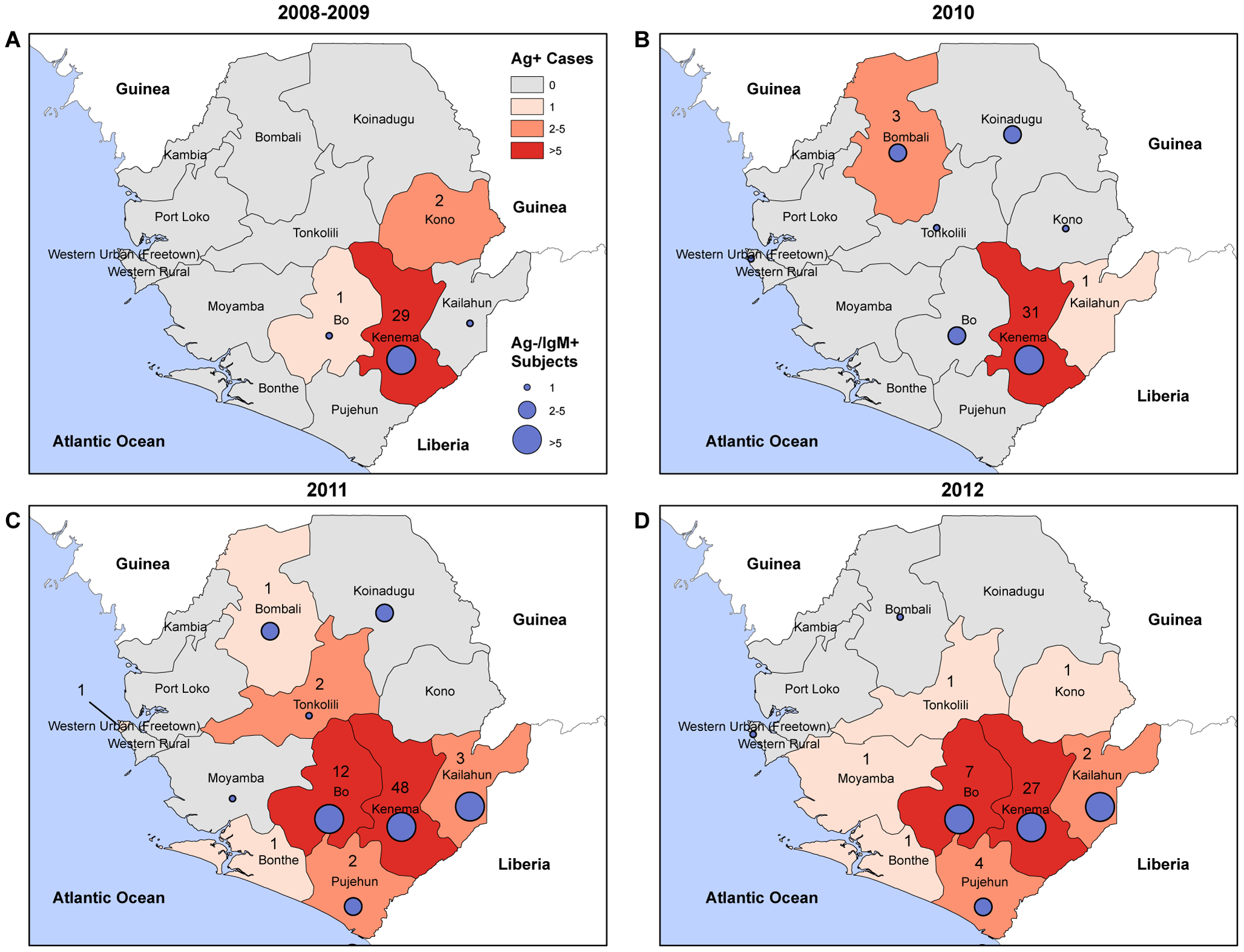Lassa fever epidemiology and demographics
|
Lassa fever Microchapters |
|
Diagnosis |
|---|
|
Treatment |
|
Case Studies |
|
Lassa fever epidemiology and demographics On the Web |
|
American Roentgen Ray Society Images of Lassa fever epidemiology and demographics |
|
Risk calculators and risk factors for Lassa fever epidemiology and demographics |
Editor-In-Chief: C. Michael Gibson, M.S., M.D. [4]; Associate Editor(s)-in-Chief: Ammu Susheela, M.D. [5]
Synonyms and keywords: Lassa hemorrhagic fever; LHF
Overview
Lassa fever is endemic in parts of west Africa including Sierra Leone, Liberia, Guinea and Nigeria; however, other neighboring countries are also at risk, as the animal vector for Lassa virus, the "multimammate rat" (Mastomys natalensis) is distributed throughout the region. Lassa fever causes 100,000-300,000 infections and approximately 5,000 deaths annually.[1]
Epidemiology and Demographics
Prevalence
The dissemination of the infection can be assessed by prevalence of antibodies to the virus in populations of:
- Sierra Leone 8–52%
- Guinea 4–55%
- Nigeria approx. 21%

- A serological survey among patients admitted with a history of fever and missionaries that had experienced a febrile illness showed that LASV was also present in Ivory Coast, Mali, and Central African Republic[2].
- The notion that LASV was endemic in larger areas of West Africa was further supported by the results of investigation of an imported case of Lassa fever in Germany in 2000.[3] During the incubation period, the index patient traveled through several countries, namely Ghana, Ivory Coast, and Burkina Faso, that were not considered to be endemic at that time[4].
- Later, cases of Lassa fever have been reported from Burkina Faso, Ivory Coast, Ghana, Senegal, Gambia, and Mali[5][6].
- The high degree of seroprevalence of LASV-specific antibodies in the general population residing in the endemic regions, although highly variable depending on the geographical location (from 1.8% to 55%) [[7] indicates that most infections are mild or possibly even asymptomatic and do not result in hospitalization. This is also supported by the findings indicating a high incidence of LASV-specific seroconversion, from 5% to 20% of the nonimmune population per year[7]. Nosocomial outbreaks are associated with higher mortality rates ranging from 36% to 65%[8].
Incidence
- According to estimations, LASV is responsible for 100,000-300,000 infections and approximately 5,000 deaths annually. Unfortunately, such estimates are crude, because surveillance for cases of the disease is not uniformly performed. In some areas of Sierra Leone and Liberia, it is known that 10%-16% of people admitted to hospitals have Lassa fever, which indicates the serious impact of the disease on the population of this region.
Age
- People of all ages who are exposed to the infection are vulnerable to get infected.
Gender
- The death rates are particularly high for women in the third trimester of pregnancy, and for fetuses, about 95% of which die in the uterus of infected pregnant mothers.
Seasonal Variation
- Studies conducted prior to the end of hostilities suggested that the highest incidence of LF in Sierra Leone occurs during the dry season (November to April).[7]
Race
- People of all ages who are exposed to the infection are vulnerable to get infected.
Developed Countries
- People hospitalized in United States with imported Lassa fever.
| Year of import | Clinical features | From | To |
| 1969 | Fever, malaise, headache, nausea, sore throat, epigastric/right upper quadrant tenderness, pleural effusion, facial/cervical edema, dysphagia, elevated transaminases, cough, dyspnea, pulmonary infiltrates, epiglottal edema, lethargy, nystagmus, lightheadedness, dizziness without vertigo, ataxia, alopecia | Nigeria | New York |
| 1975 | Abdominal pain, diarrhea, fever, headache, myalgia, arthralgia, conjunctival injection, lymphadenopathy, weight loss, pleuritic chest pain, pleural effusion, unilateral deafness | Sierra Leone | Washington, DC |
| 1976 | Abdominal cramps, nausea, vomiting, diarrhea, fatigue, headache, retroorbital pain, neck/back pain, paresthesias, right ear pain, fever, vertigo, syncope, dysmorphopsias, alopecia, weight loss, ecchymoses, insomnia, depression, hypotension, left-sided facial weakness, right-sided Babinski reflex, Weber test lateralized to the left | Sierra Leone | Washington, DC |
| 1989 | Shaking chills, fever, sore throat, myalgia, headache, dysphagia, bloody diarrhea, elevated transaminases, hypotension, adult respiratory distress syndrome, death | Nigeria | Chicago, IL |
| 2004 | Chills, fever, sore throat, diarrhea, back pain, adult respiratory distress syndrome, death | Sierra Leone and Liberia|style="padding: 5px 5px; background: #F2F2F2;"|Trenton, NJ |
As of May, 2005. Data from the Center of Disease Control and Prevention
Developing Countries
- Since its initial discovery, nosocomial outbreaks of Lassa fever have occurred repeatedly in following countires.
- Sierra Leone: Panguma, Kenema, 1971–83, 1997, Liberia: Zorzor, 1972; Phebe 1972, 1977, 1982; Ganta 1977, 1982 and Nigeria: Jos, 1970, 1993; Onitsha, 1974; Zonkwa, 1975; Vom, 1975–77, Imo, 1989; Lafia, 1993; and Irrua, 2004 [9][10][11],[12][13][14][15]
- In Guinea, some acute but isolated cases were recorded in hospitals and a single rural outbreak was recorded on the Sierra Leone border in 1982–83[16].
- Between these two areas, namely in Côte d'Ivoire, Ghana, Togo and Benin, no outbreak has ever been recorded, though isolated cases show evidence of viral circulation in that area[17][18]. Lassa fever therefore appears to have 2 geographically separate endemic areas: the Mano River region (Guinea, Sierra Leone, Liberia) in the West, and Nigeria in the East.
- Geographic distribution of patients presenting to the hospital in Sierra Leone with Lassa fever.
 |
 |
References
- ↑ 1.0 1.1 "The Centers for Disease Control and Prevention facts sheets" (PDF).
- ↑ Frame JD (1975). "Surveillance of Lassa fever in missionaries stationed in West Africa". Bull World Health Organ. 52 (4–6): 593–8. PMC 2366625. PMID 1085213.
- ↑ Yun NE, Walker DH (2012). "Pathogenesis of Lassa fever". Viruses. 4 (10): 2031–48. doi:10.3390/v4102031. PMC 3497040. PMID 23202452.
- ↑ Günther S, Emmerich P, Laue T, Kühle O, Asper M, Jung A; et al. (2000). "Imported lassa fever in Germany: molecular characterization of a new lassa virus strain". Emerg Infect Dis. 6 (5): 466–76. doi:10.3201/eid0605.000504. PMC 2627947. PMID 10998376.
- ↑ Gonzalez JP, Emonet S, de Lamballerie X, Charrel R (2007). "Arenaviruses". Curr Top Microbiol Immunol. 315: 253–88. PMID 17848068.
- ↑ Safronetz D, Lopez JE, Sogoba N, Traore' SF, Raffel SJ, Fischer ER; et al. (2010). "Detection of Lassa virus, Mali". Emerg Infect Dis. 16 (7): 1123–6. doi:10.3201/eid1607.100146. PMC 3321918. PMID 20587185.
- ↑ 7.0 7.1 7.2 McCormick JB, Webb PA, Krebs JW, Johnson KM, Smith ES (1987). "A prospective study of the epidemiology and ecology of Lassa fever". J Infect Dis. 155 (3): 437–44. PMID 3805771.
- ↑ Monath TP, Mertens PE, Patton R, Moser CR, Baum JJ, Pinneo L; et al. (1973). "A hospital epidemic of Lassa fever in Zorzor, Liberia, March-April 1972". Am J Trop Med Hyg. 22 (6): 773–9. PMID 4745236.
- ↑ Carey DE, Kemp GE, White HA, Pinneo L, Addy RF, Fom AL; et al. (1972). "Lassa fever. Epidemiological aspects of the 1970 epidemic, Jos, Nigeria". Trans R Soc Trop Med Hyg. 66 (3): 402–8. PMID 5046380 : 5046380 Check
|pmid=value (help). - ↑ Bowen GS, Tomori O, Wulff H, Casals J, Noonan A, Downs WG (1975). "Lassa fever in Onitsha, East Central State, Nigeria in 1974". Bull World Health Organ. 52 (4–6): 599–604. PMC 2366632. PMID 1085214.
- ↑ Frame JD, Jahrling PB, Yalley-Ogunro JE, Monson MH (1984). "Endemic Lassa fever in Liberia. II. Serological and virological findings in hospital patients". Trans R Soc Trop Med Hyg. 78 (5): 656–60. PMID 6390808.
- ↑ Fisher-Hoch SP, Tomori O, Nasidi A, Perez-Oronoz GI, Fakile Y, Hutwagner L; et al. (1995). "Review of cases of nosocomial Lassa fever in Nigeria: the high price of poor medical practice". BMJ. 311 (7009): 857–9. PMC 2550858. PMID 7580496.
- ↑ Bajani MD, Tomori O, Rollin PE, Harry TO, Bukbuk ND, Wilson L; et al. (1997). "A survey for antibodies to Lassa virus among health workers in Nigeria". Trans R Soc Trop Med Hyg. 91 (4): 379–81. PMID 9373625.
- ↑ Fisher-Hoch SP, McCormick JB (2004). "Lassa fever vaccine". Expert Rev Vaccines. 3 (2): 189–97. doi:10.1586/14760584.3.4.S189. PMID 15056044.
- ↑ Omilabu SA, Badaru SO, Okokhere P, Asogun D, Drosten C, Emmerich P; et al. (2005). "Lassa fever, Nigeria, 2003 and 2004". Emerg Infect Dis. 11 (10): 1642–4. doi:10.3201/eid1110.041343. PMC 3366737. PMID 16355508.
- ↑ Bausch DG, Demby AH, Coulibaly M, Kanu J, Goba A, Bah A; et al. (2001). "Lassa fever in Guinea: I. Epidemiology of human disease and clinical observations". Vector Borne Zoonotic Dis. 1 (4): 269–81. PMID 12653127.
- ↑ Akoua-Koffi C, Ter Meulen J, Legros D, Akran V, Aïdara M, Nahounou N; et al. (2006). "[Detection of anti-Lassa antibodies in the Western Forest area of the Ivory Coast]". Med Trop (Mars). 66 (5): 465–8. PMID 17201291.
- ↑ Borremans B, Vossen R, Becker-Ziaja B, Gryseels S, Hughes N, Van Gestel M; et al. (2015). "Shedding dynamics of Morogoro virus, an African arenavirus closely related to Lassa virus, in its natural reservoir host Mastomys natalensis". Sci Rep. 5: 10445. doi:10.1038/srep10445. PMID 26022445.
- ↑ 19.0 19.1 "Lassa Fever in Post-Conflict Sierra Leone".